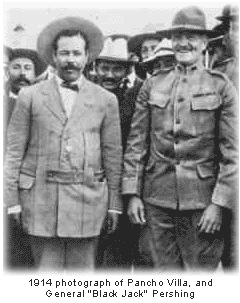The installation of the Venustiano Carranza regime in Mexico City did not result in lasting tranquility with the United States. Events became so chaotic that the State Department issued a warning to U.S. citizens living in Mexico to leave the country. Thousands took the advice.
 One of Carranza’s allies, Francisco “Pancho” Villa, turned against the new president, claiming with some justification that Carranza was not making good on his reform pledges. Villa himself was a rascal, an enormous self-promoter and an occasional champion of the underprivileged. Villa was initially engaged in a struggle on behalf of the government against rival forces. He became the darling of Hollywood filmmakers and U.S. newspapermen by granting open access to his campaigns. Some claimed that he actually staged battles for the cameras and publicity.
One of Carranza’s allies, Francisco “Pancho” Villa, turned against the new president, claiming with some justification that Carranza was not making good on his reform pledges. Villa himself was a rascal, an enormous self-promoter and an occasional champion of the underprivileged. Villa was initially engaged in a struggle on behalf of the government against rival forces. He became the darling of Hollywood filmmakers and U.S. newspapermen by granting open access to his campaigns. Some claimed that he actually staged battles for the cameras and publicity.
Villa's horizons broadened considerably when he began to seek control of the Mexican government for himself. His method was to weaken Carranza by provoking problems with the United States. On January 10, 1916, his forces attacked a group of American mining engineers at Santa Ysabel, killing 18. The Americans had been invited into the area by Carranza for the purpose of reviving a number of abandoned mines.
Pancho Villa’s men struck next on March 9, by crossing the border to attack Columbus, New Mexico, the home of a small garrison. The town was burned and 17 Americans were killed in the raid. War fever broke out across the United States. Senator Henry F. Ashurst of Arizona suggested that “more grape shot and less grape juice” was needed, a none-too-subtle indictment of the teetotaling secretary of state William Jennings Bryan.
President Wilson abandoned "watchful waiting" and appointed General John J. “Black Jack” Pershing to head a punitive force of 12,000 soldiers to locate Villa — dead or alive. Carranza was not enthusiastic about the incursion of an American army onto Mexican soil, and became even less so the farther south the soldiers marched. Despite several close calls, Villa always managed to escape the larger and better-equipped invaders. An exasperated Pershing cabled Washington: “Villa is everywhere, but Villa is nowhere.”
The chase lasted nine months and finally ended in February 1917, when Wilson summoned the soldiers home in anticipation of imminent hostilities with Germany.
A new Mexican constitution had been adopted in January 1917. The document sharply reduced the powers of The Roman Catholic Church and foreigners, which reflected popular disgust with those two elements of oppression. Carranza was formally elected president by a democratic vote and was recognized by the United States. Pancho Villa was a popular hero in many quarters in Mexico, but had also made many enemies over the years. He was ambushed and killed several years later, probably at the instigation of then president Obregon.